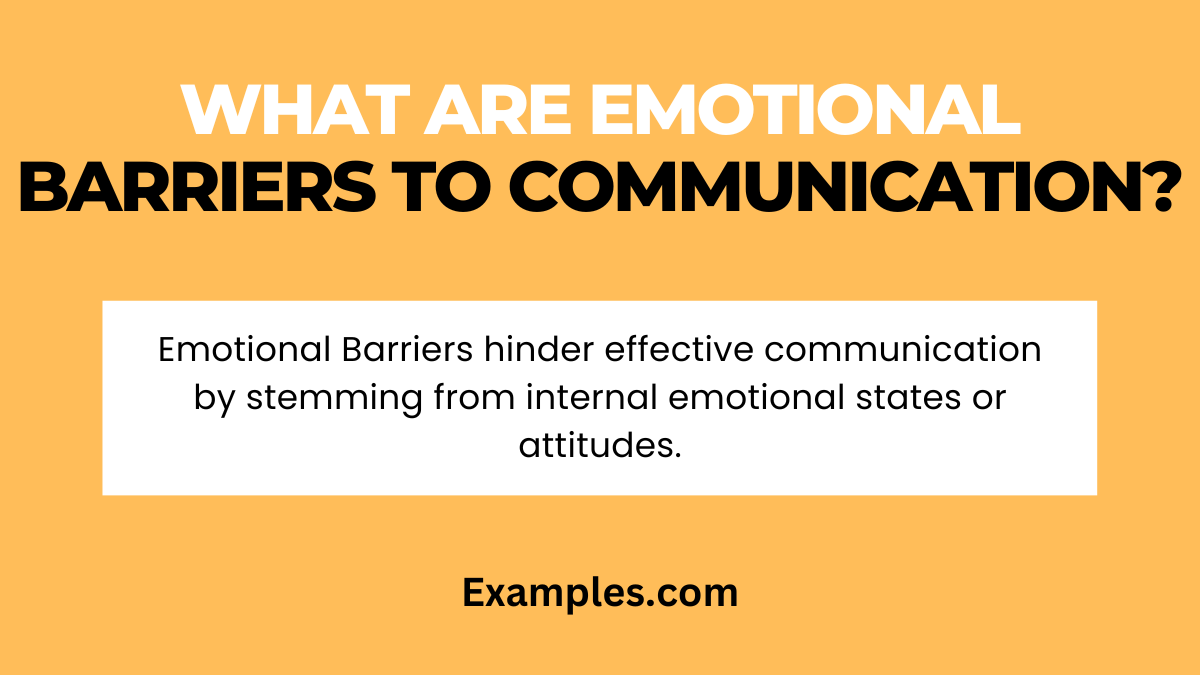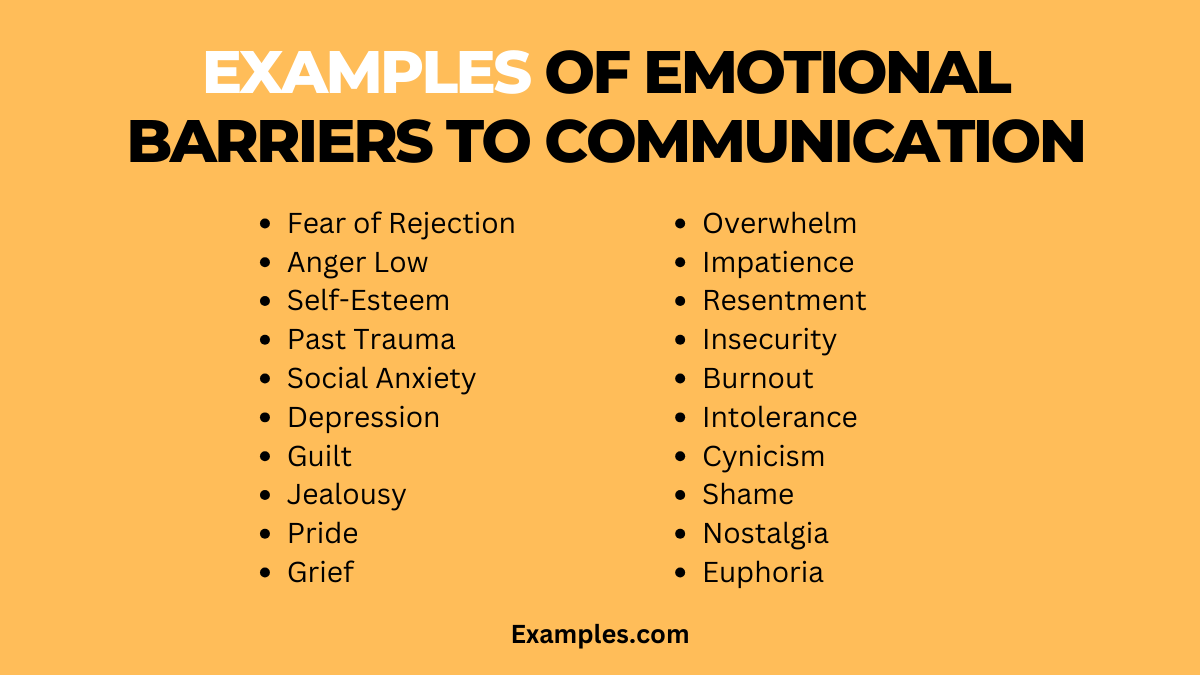19+ Emotional Barriers to Communication Examples
Emotional Barriers to Communication are internal obstacles caused by emotions, attitudes, or personal discomforts that can hinder effective information exchange. These barriers, like fear, anger, or frustration, can prevent open and honest dialogue, impacting personal and professional relationships. This guide explores the concept of emotional barriers, offering insights into how they affect communication and providing practical tips to manage and overcome these challenges for healthier, more productive interactions.
What are Emotional Barriers to Communication?

Emotional Barriers to Communication refer to the internal emotional states or attitudes that obstruct effective exchange of ideas and feelings. These barriers can range from anxiety, mistrust, and insecurity to prejudice and emotional baggage, all of which can significantly impact the way messages are conveyed and perceived. Understanding these barriers is essential in developing strategies for more empathetic, transparent, and successful communication in various settings.
What is the Best Example of Emotional Barriers to Communication?

A common example of Emotional Barriers to Communication is when personal insecurities or past negative experiences lead to reluctance in sharing ideas or feelings, particularly in group settings. This hesitation can stifle creativity and collaboration, highlighting the importance of creating a supportive, non-judgmental environment that encourages openness and mutual respect. Addressing emotional barriers in such contexts can lead to more fruitful and engaging communication, fostering a culture of trust and understanding.
20 Examples of Emotional Barriers to Communication

Emotional barriers in communication are internal obstacles shaped by personal feelings, attitudes, and perceptions. These barriers can significantly hinder the ability to express oneself clearly and to understand others effectively. Addressing these emotional barriers is crucial for healthy and productive interactions in various aspects of life, including professional environments, personal relationships, and social interactions. This section outlines 20 distinct examples of emotional barriers, offering insights into their impact on communication and ways to navigate these challenges.
- Fear of Rejection: Worrying about negative responses can inhibit sharing thoughts.
“I hesitate to suggest new ideas, fearing they might be rejected.” - Anger: Strong feelings of anger can lead to aggressive or ineffective communication.
“When I’m angry, I struggle to express myself constructively.” - Low Self-Esteem: Feeling inadequate can prevent individuals from voicing their opinions.
“My lack of confidence often stops me from speaking up in meetings.” - Past Trauma: Unresolved emotional issues from the past can impede open communication.
“Past experiences have made it difficult for me to trust and open up.” - Social Anxiety: Fear of social situations can hinder interaction and expression.
“In social gatherings, my anxiety often keeps me from joining conversations.” - Depression: Feelings of sadness or hopelessness can limit effective communication.
“When I’m depressed, I find it hard to communicate my needs clearly.” - Guilt: Guilt can lead to avoidance of certain topics or people.
“Feeling guilty about a past incident makes it hard for me to approach them.” - Jealousy: Jealous feelings can distort perceptions and interactions.
“My jealousy sometimes affects how I interpret their actions and words.” - Pride: Excessive pride can prevent admitting mistakes or needing help.
“My pride often stops me from asking for assistance or clarification.” - Grief: The emotional pain of loss can lead to withdrawal from communication.
“Since my loss, I find it challenging to engage in conversations like before.” - Overwhelm: Being overwhelmed can lead to shutting down communication.
“When I’m overwhelmed, I tend to retreat and stop communicating effectively.” - Impatience: Impatience can result in rushed and unclear communication.
“My impatience sometimes makes me interrupt others or not listen fully.” - Resentment: Holding onto bitterness can taint communication with others.
“Resentment from past conflicts hinders my ability to communicate openly with them.” - Insecurity: Insecurities about oneself can lead to defensive communication.
“Feeling insecure, I often react defensively instead of discussing calmly.” - Burnout: Exhaustion can reduce the energy and focus needed for effective communication.
“When I’m burnt out, I struggle to articulate my thoughts clearly.” - Intolerance: Being intolerant to different views can block open dialogue.
“My intolerance for opposing opinions often shuts down meaningful conversations.” - Cynicism: A cynical attitude can lead to dismissive or negative communication.
“My cynical view sometimes makes me dismiss others’ ideas prematurely.” - Shame: Feeling ashamed can hinder discussing certain topics or expressing oneself.
“Shame about my situation makes it difficult for me to talk about it.” - Nostalgia: Longing for the past can affect present communication and expectations.
“Caught up in nostalgia, I sometimes find it hard to accept current changes.” - Euphoria: Excessive excitement can lead to overlooking important communication details.
“In my euphoria, I often miss out on key points in discussions.”
These examples underscore the importance of recognizing and addressing Emotional Barriers to Communication to ensure open, honest, and effective interactions in various life aspects.
Emotional Barriers to Communication in the Workplace
In the workplace, emotional barriers to communication can significantly impact team dynamics, productivity, and employee morale. These barriers often stem from personal insecurities, stress, workplace conflicts, and hierarchical pressures. Overcoming these challenges is essential for creating a supportive and effective work environment.
- Stress from Deadlines: Pressure to meet deadlines can hinder clear thinking and communication.
- Fear of Speaking Up: Concern about negative feedback or judgment from superiors or peers.
- Interpersonal Conflicts: Tensions with colleagues can lead to guarded or hostile communication.
- Job Insecurity: Worrying about job stability can make employees less communicative or open.
- Burnout: Exhaustion can lead to a lack of engagement and poor communication.
- Office Politics: Navigating complex office dynamics can lead to cautious, unclear communication.
- Resentment towards Management: Feeling undervalued or overlooked by leadership can hinder open dialogue.
- Lack of Recognition: Frustration from not being acknowledged can lead to disengagement.
Addressing these emotional barriers requires empathy, open communication policies, and a supportive work culture.
Emotional Barriers to Communication in Healthcare
In healthcare, emotional barriers to communication can affect the quality of patient care and collaboration among healthcare professionals. These barriers may include stress, emotional fatigue, personal biases, and the pressure of making critical decisions.
- Compassion Fatigue: Constant exposure to patient suffering can lead to emotional exhaustion and withdrawal.
- Stress from High-stakes Decisions: The pressure of making life-altering decisions can impact communication clarity.
- Prejudices about Patients: Biases can affect how healthcare providers communicate with diverse patients.
- Grief from Patient Loss: Dealing with loss can affect healthcare professionals’ ability to communicate effectively.
- Patient Anxiety: Patients’ fear or anxiety about their health can hinder open communication.
- Miscommunication in Multidisciplinary Teams: Emotional tensions in diverse teams can lead to misunderstandings.
- Emotional Overwhelm: Being overwhelmed by workload or patient needs can impede effective communication.
- Fear of Misdiagnosis: Concern about making mistakes can lead to cautious or vague communication.
Creating an environment where healthcare professionals can express and manage their emotions is crucial for effective communication.
How to Overcome Emotional Barriers in Communication
Overcoming emotional barriers in communication is essential for fostering open and effective dialogue. Emotional barriers, like fear, mistrust, or frustration, can severely hinder the exchange of ideas and feelings. Addressing these barriers requires a mix of self-awareness, empathy, and practical strategies.
- Self-Awareness: Recognize and understand your own emotions before engaging in communication.
- Active Listening: Focus on truly hearing and understanding the other person’s perspective.
- Empathy: Show genuine concern and understanding for the emotions of others.
- Open and Honest Dialogue: Encourage sharing feelings and concerns without fear of judgment.
- Stress Management: Develop techniques to manage stress and anxiety effectively.
- Positive Mindset: Maintain a positive and constructive attitude during interactions.
- Building Trust: Create a safe and trusting environment for open communication.
- Seeking Feedback: Be open to receiving and acting on feedback from others.
- Professional Support: Consider counseling or therapy for deeper emotional issues impacting communication.
- Practicing Patience: Be patient with yourself and others as emotional barriers are navigated.
Implementing these approaches can greatly enhance the ability to communicate effectively, even when emotions are high.
Emotional barriers present significant challenges to clear and effective communication, but they can be overcome with the right approach. This guide has outlined strategies for navigating these barriers, emphasizing the importance of empathy, self-awareness, and open dialogue. By addressing emotional barriers, we can improve our communication skills, leading to more meaningful and productive interactions in both personal and professional spheres. Understanding and managing these barriers is key to fostering healthy, open, and effective communication.



